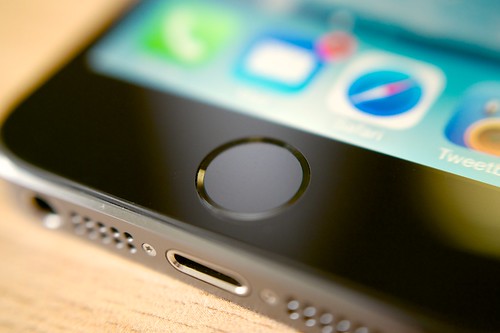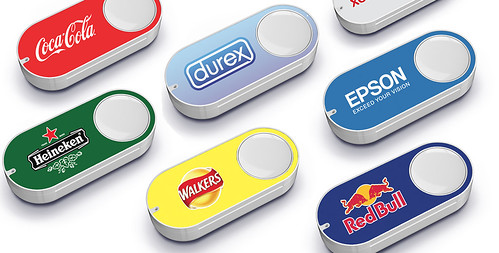
Something about this is going to change in September. But what? Photo by janitors on Flickr.
You can now sign up to receive each day’s Start Up post by email. You’ll need to click a confirmation link, so no spam.
A selection of 11 links for you. Use them wisely. I’m charlesarthur on Twitter. Observations and links welcome.
Disruptive robocalling • Global Guerrillas
»Three months ago, I wrote up a worst case scenario for how the US could end up in a civil war this fall. Unfortunately, nothing has changed. The conditions that make the scenario possible are still valid.
In fact, in one way it has gotten worse: one of the theoretical methods of disruption that I featured in the scenario was recently used in the real world. In my scenario, robocalling was used to shut down polling places to skew election results and plunge the US into chaos.
«
So, how’s your day going so far?
link to this extract
Apple Watch is already a $10bn business • Above Avalon
»Heading into this year’s WWDC, Apple Watch expectations were at a low. The most recent comments from Apple management about Watch sales being focused around the holidays implied Watch sales had slowed somewhat materially in recent months. Developer interest and buzz around watchOS was lackluster, and recent price drops introduced questions about customer demand.
Things changed following Apple’s WWDC keynote. It was clear Apple had no plans of slowing down with Apple Watch. More importantly, Apple was willing to make changes to Apple Watch software. As seen with the rethought user interface included in watchOS 3, Apple spent the past year studying how people were using Apple Watch. Friction points such as a clunky interface and little-used features, including Glances, were removed. Instead, Apple went back to the basics with a simpler interface and additional focus on Watch faces as the device’s most valued real estate. (Additional thoughts from WWDC concerning watchOS 3 are available here).
Some people interpreted the changes found in watchOS 3 as evidence that Apple admitted it was wrong with Apple Watch. I disagree. That type of interpretation not only ignores everything that Apple got right about Apple Watch, such as Watch bands, but also ignores reality. Apple Watch financials portray a different story. Apple Watch’s first year was not the disaster that many are now implying.
«
WatchOS 3 really is a lot quicker, and more useful, than the first versions. Cybart reckons more than 12m have been sold. By contrast, Android Wear downloads – which seem to be the correct proxy for Android Wear sales – are still below 5m.
link to this extract
Input masks: violating user expectations • ignore the code
»When designing forms, there’s a pretty deep chasm between the needs of the developer, and the needs of the user. Developers want structured, normalized data. Users want to enter data in whatever format suits them best.
Forcing people to enter structured data causes usability problems.
What do you mean, it’s not a valid phone number? Looks valid to me – except that the backend wants just numbers, no special characters, and isn’t smart enough to strip out all of the characters that the user has entered.
Commonly, designers try to solve this by telling people what kind of format data needs to be in. This can be done using placeholders that show example data in the correct format.
The problem here is that the placeholder disappears as soon as people start typing, so exactly when they actually need this information, it’s no longer visible.
«
And with credit card numbers, things get really annoying, as Mathis points out.
link to this extract
Pakistan’s troll problem • The New Yorker
»Among many religiously conservative Pakistanis, [female lawyer Naghat] Dad said, there is a belief that women should not be using technology at all. “I could only use the Internet and my mobile phone while at work,” she told me. There are more than twenty-three million Facebook accounts registered in Pakistan, but in some cases, Dad said, “women who experience harassment on Facebook don’t want to make a formal complaint, as to do so is to admit to owning a profile.” As more women continue to join social-media platforms, the resistance to their presence has increased. Last August, a gang of men targeted a group of female doctors in Lahore, stealing photographs and private messages from their WhatsApp and Facebook accounts before demanding money. “The threat of disgrace made these professional women soft targets,” Shamsi said. “This on top of the battles they fight just for the right to work.” Dad’s organization has two staff members devoted to working on Facebook complaints, but she deals with the public herself, and she now receives more calls from women each day than she can handle.
In general, US-based social-media companies have been slow to address harassment on their platforms in different cultural contexts — and even, many would argue, in their own.
«
“OK Google…” • OK Google
It’s a list of the voice commands you can ask after “OK Google..” on Google’s systems. Would love to see something comparable for Siri.
link to this extract
The ultimate Apple I/O death chart • The Verge
»One of the most strongly-held arguments about Apple removing the headphone jack is that Apple has historically been first to drop a legacy technology, sometimes even before the rest of the industry is ready. Apple’s vertical integration, passionate userbase, and scale (both historically small and now immensely huge) allow it to push big changes in a way that few other companies can pull off. The floppy, SCSI, optical drives, VGA — all killed by Apple years before vanishing from the rest of the industry.
But how long does it really take Apple to kill legacy tech? We threw together a chart to map it out. (It would be fun to do this across the entire tech industry, but finding all that data seems virtually impossible. If you figure it out email me and we’ll run it!)
«
QWERTY still in use, though I guess that’s not a “port”. A neat corollary to this would be the adoption of wireless ports. Wi-Fi arrived in July 1999; Bluetooth, in 2003. Infrared came and went.
Also: how great to have a piece of simple, informative journalism that answers a question you didn’t realise you wanted answered until you saw it.
link to this extract
Hillary Clinton’s initiative on technology and innovation • HillaryClinton.com
The would-be president who doesn’t say outrageous things (and thus gets no coverage outside the US) has a detailed set of tech proposals, which has lots of “would be nice” ideas but also this:
»Copyrights encourage creativity and incentivize innovators to invest knowledge, time, and money into the generation of myriad forms of content. However, the copyright system has languished for many decades, and is in need of administrative reform to maximize its benefits in the digital age. Hillary believes the federal government should modernize the copyright system by unlocking — and facilitating access to — orphan works that languished unutilized, benefiting neither their creators nor the public.
She will also promote open-licensing arrangements for copyrighted material and data supported by federal grant funding, including in education, science, and other fields. She will seek to develop technological infrastructure to support digitization, search, and repositories of such content, to facilitate its discoverability and use.
And she will encourage stakeholders to work together on creative solutions that remove barriers to the seamless and efficient licensing of content in the U.S. and abroad.
«
There’s also privacy, smart government, more broadband, and plenty more.
link to this extract
Android fragmentation may not be as pronounced as Google’s distribution numbers would have you believe, says Apteligent • Android Police
»as Apteligent’s monthly data report points out, Google doesn’t take into consideration two important factors: devices that don’t have the Play Store installed (ie Chinese handsets mostly) and device usage. A phone may access the Play Store, but it may not be actively used. Once that’s taken into account, the image shifts greatly and you can see that there are far less devices in active use that are still running older versions of Android.
As the table and graph aboe show, Android usage distribution puts Lollipop at around half of the devices (vs. ~35% in Google’s June numbers) and Marshmallow at almost double what Google says (19.4% vs. 10.1%). Apteligent’s usage distribution drops KitKat from around 31% in Google’s stats to roughly 25%, Jelly Bean from ~19% to 6.8%, and shows that everything prior (ICS, Honeycomb, Gingerbread, and Froyo) is practically irrelevant.
Now sure, these are numbers taken from Apteligent’s report, which is based on devices that have apps with the Apteligent SDK installed, but they do show a new picture of Android’s version distributions.
«
Sure, they do; but still suggest that just under half of all devices with appreciable use are running a version of Android released between October 2013 and November 2014. Worth looking at the full PDF, which has lots more details of other devices and crashes too.
link to this extract
iPhone 7 again rumoured to have flush, touch-sensitive home button • Mac Rumors
»Apple may be planning to introduce a Force Touch home button on the iPhone 7, according to analysts at Cowen and Company (via Business Insider). Citing supply chain “field checks,” Cowen and Company predicts the iPhone 7 will do away with a physical home button, instead adopting a home button that sits flush with the phone.
Apple’s Force Touch technology will reportedly be built into the home button to provide haptic feedback when pressed, much like the Force Touch trackpad on Apple’s most recent MacBooks. With haptic feedback, iPhone users would still feel the sensation of pressing on the home button even without a button to actually depress.
Cowen and Company has a mixed track record, but it’s worth noting that we’ve heard two other rumors about a redesigned home button on the iPhone 7. In April, DigiTimes said Apple was testing a touch-sensitive home button that fits flush with the phone, and a highly sketchy image of what was said to be an iPhone 7 with a touch-sensitive home button surfaced in mid-June.
Given the unreliability of each of the home button rumors, the information should be viewed with some skepticism until confirmed by a more reliable source, but when viewed alongside rumors of improved waterproofing and the removal of the headphone jack, a flush home button is not a rumor that seems entirely out of the question.
«
In September 2015, I wrote that Force/3D Touch was clearly part of a path to replace the physical iPhone (and iPad) home button:
»I bet that mechanical failure of Home buttons is one thing that keeps showing up in Apple’s fault reports. Broken screens are easily replaced (and people can get by with broken screens for a looong time), but broken home buttons not so. Grit can get in. Water can get in. Constant movement isn’t ideal in electronics. You might say that it’s just tough if peoples’ Home buttons break, but compared to Android phones which don’t have them, it’s an obvious point of weakness – and customer dissatisfaction.
However, the Home button is needed as the place where your fingerprint is read. But that doesn’t need a moving home button; it just needs a circle of sapphire glass through which your print is read.
«
Feeling increasingly confident about that one.
link to this extract
Does Brexit herald a new era for big data-driven forecasting? • Forbes
»Discussion does not imply support. In the Iowa caucuses, Sanders led Clinton in Facebook mentions by 73% to 25%, while actual voting had them nearly tied, while in 2012 Twitter showed Obama dominating the Southern states ultimately won by Romney. Most recently, Facebook showed Sanders beating Clinton by a landslide in Facebook discussion, though it did also show Trump leading on the Republican side. Of course, social media data is also becoming increasingly difficult to access as a data source.
Web searches are increasingly being used as a metric to understand society. Google Trends published a map looking at searches across the UK in the first week of June, showing that Leave dominated searches across the entire country outside of a handful of pockets. Even Scotland was overwhelmingly searching about Leave. In reality, the final voting results looked quite different. As with social media conversation, heavy search interest simply implies that people are intensely interested in the topic, not that they support or condemn it.
Interestingly, the timeline of search intensity for the two terms within the UK offers a slightly different picture. UK searchers were searching for Remain and Leave nearly neck and neck up until the morning the polls opened, at which point Remain climbed to 8% more than Leave. Yet, around 4:30PM local time, Leave suddenly surged to 15% greater and by 8:30PM local time Leave was 59% ahead and by 10:30 it was 79% ahead, before beginning to head back down.
«
Basically: this stuff doesn’t tell us anything, but in the absence of anything else we like to pretend it does, and anyway there’s no other useful data. (Scotland voted comprehensively to Remain.)
link to this extract
In a Google future, drivers may exchange their data for infotainment • Car and Driver Blog
»In exchange for vehicle content, Google might want details that include data about the vehicle itself—mileage, condition of certain components like tires, details on serial numbers of vehicle systems, and the like. It may also demand information on the occupants, including the types of content they’ve stored in vehicle systems, preferred genres of music, video content, and more.
With a company like Google, which has interests in the automotive realm that run from autonomous cars to its Android Auto phone-projection system, the consolidation of control worries John Simpson, director of the Privacy Project for Consumer Watchdog, a nonprofit organization that has tracked Google’s automotive efforts and frequently criticizes the company’s privacy practices.
“This is an egregious invasion of a motorist’s privacy, and I do fear that people who refuse to provide personal data will be unfairly locked out of infotainment systems,” he said. Going further down the line, Simpson said, “The privacy concerns are even greater with self-driving autonomous vehicles. Google could easily offer a self-driving car that would only operate if personal data were turned over to the company.”
«
Hmm. There are lots of insurance companies which already track your car (for younger drivers) to offer reductions in insurance costs. But seeking data about what you’re listening to? Perhaps it’s just covering all the bases.
link to this extract
Errata, corrigenda and ai no corrida: apologies for the late arrival of the blogpost and the email yesterday. The finger usually employed to press the “schedule” button has been reassigned to other duties.




/cdn0.vox-cdn.com/uploads/chorus_asset/file/6725017/apple-death-chart-5-01.0.png)



/cdn0.vox-cdn.com/uploads/chorus_asset/file/6705181/anki-cozmo-robot-animation-1.0.gif)





















